Capital Budgeting Techniques for Northern Lights Inc
VerifiedAdded on 2023/06/03
|15
|2711
|417
AI Summary
This report highlights the capital budgeting techniques used by Northern Lights Inc in order to evaluate its new production line in efficient bulb markets. Sensitivity analysis of the project has also been done.
Contribute Materials
Your contribution can guide someone’s learning journey. Share your
documents today.

RUNNING HEAD: FINANCE
Capital budgeting
Capital budgeting
Secure Best Marks with AI Grader
Need help grading? Try our AI Grader for instant feedback on your assignments.
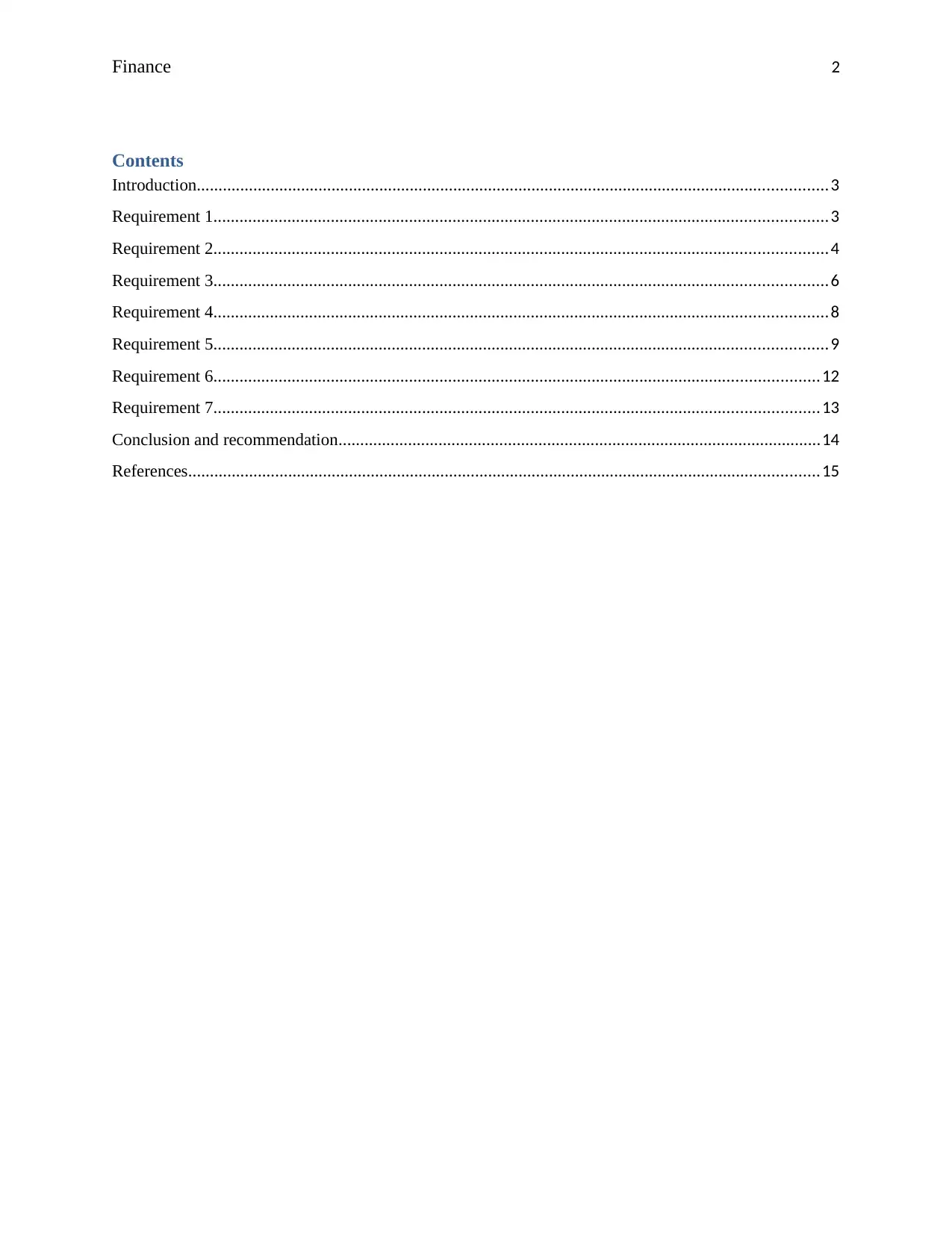
Finance 2
Contents
Introduction.................................................................................................................................................3
Requirement 1.............................................................................................................................................3
Requirement 2.............................................................................................................................................4
Requirement 3.............................................................................................................................................6
Requirement 4.............................................................................................................................................8
Requirement 5.............................................................................................................................................9
Requirement 6...........................................................................................................................................12
Requirement 7...........................................................................................................................................13
Conclusion and recommendation...............................................................................................................14
References.................................................................................................................................................15
Contents
Introduction.................................................................................................................................................3
Requirement 1.............................................................................................................................................3
Requirement 2.............................................................................................................................................4
Requirement 3.............................................................................................................................................6
Requirement 4.............................................................................................................................................8
Requirement 5.............................................................................................................................................9
Requirement 6...........................................................................................................................................12
Requirement 7...........................................................................................................................................13
Conclusion and recommendation...............................................................................................................14
References.................................................................................................................................................15
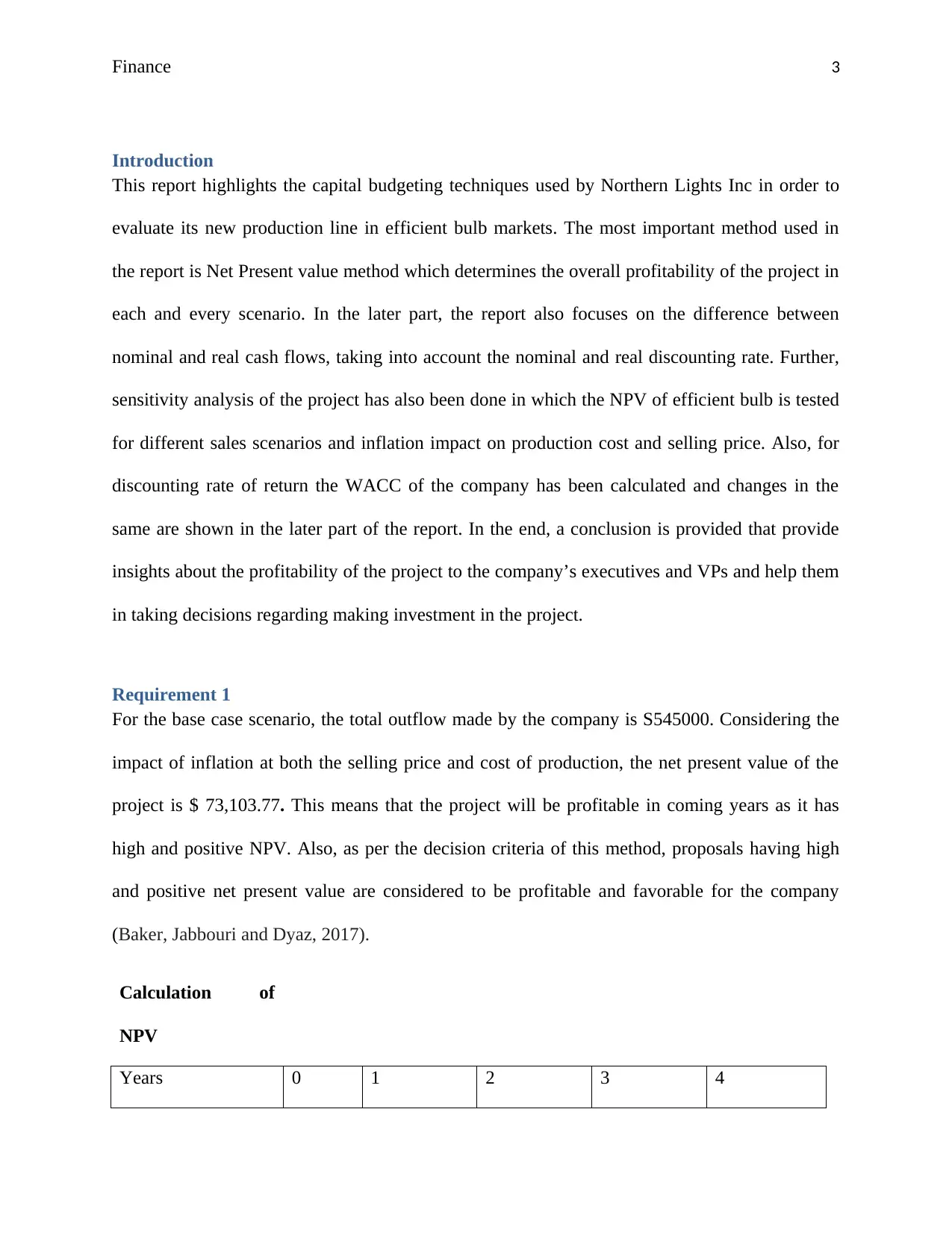
Finance 3
Introduction
This report highlights the capital budgeting techniques used by Northern Lights Inc in order to
evaluate its new production line in efficient bulb markets. The most important method used in
the report is Net Present value method which determines the overall profitability of the project in
each and every scenario. In the later part, the report also focuses on the difference between
nominal and real cash flows, taking into account the nominal and real discounting rate. Further,
sensitivity analysis of the project has also been done in which the NPV of efficient bulb is tested
for different sales scenarios and inflation impact on production cost and selling price. Also, for
discounting rate of return the WACC of the company has been calculated and changes in the
same are shown in the later part of the report. In the end, a conclusion is provided that provide
insights about the profitability of the project to the company’s executives and VPs and help them
in taking decisions regarding making investment in the project.
Requirement 1
For the base case scenario, the total outflow made by the company is S545000. Considering the
impact of inflation at both the selling price and cost of production, the net present value of the
project is $ 73,103.77. This means that the project will be profitable in coming years as it has
high and positive NPV. Also, as per the decision criteria of this method, proposals having high
and positive net present value are considered to be profitable and favorable for the company
(Baker, Jabbouri and Dyaz, 2017).
Calculation of
NPV
Years 0 1 2 3 4
Introduction
This report highlights the capital budgeting techniques used by Northern Lights Inc in order to
evaluate its new production line in efficient bulb markets. The most important method used in
the report is Net Present value method which determines the overall profitability of the project in
each and every scenario. In the later part, the report also focuses on the difference between
nominal and real cash flows, taking into account the nominal and real discounting rate. Further,
sensitivity analysis of the project has also been done in which the NPV of efficient bulb is tested
for different sales scenarios and inflation impact on production cost and selling price. Also, for
discounting rate of return the WACC of the company has been calculated and changes in the
same are shown in the later part of the report. In the end, a conclusion is provided that provide
insights about the profitability of the project to the company’s executives and VPs and help them
in taking decisions regarding making investment in the project.
Requirement 1
For the base case scenario, the total outflow made by the company is S545000. Considering the
impact of inflation at both the selling price and cost of production, the net present value of the
project is $ 73,103.77. This means that the project will be profitable in coming years as it has
high and positive NPV. Also, as per the decision criteria of this method, proposals having high
and positive net present value are considered to be profitable and favorable for the company
(Baker, Jabbouri and Dyaz, 2017).
Calculation of
NPV
Years 0 1 2 3 4
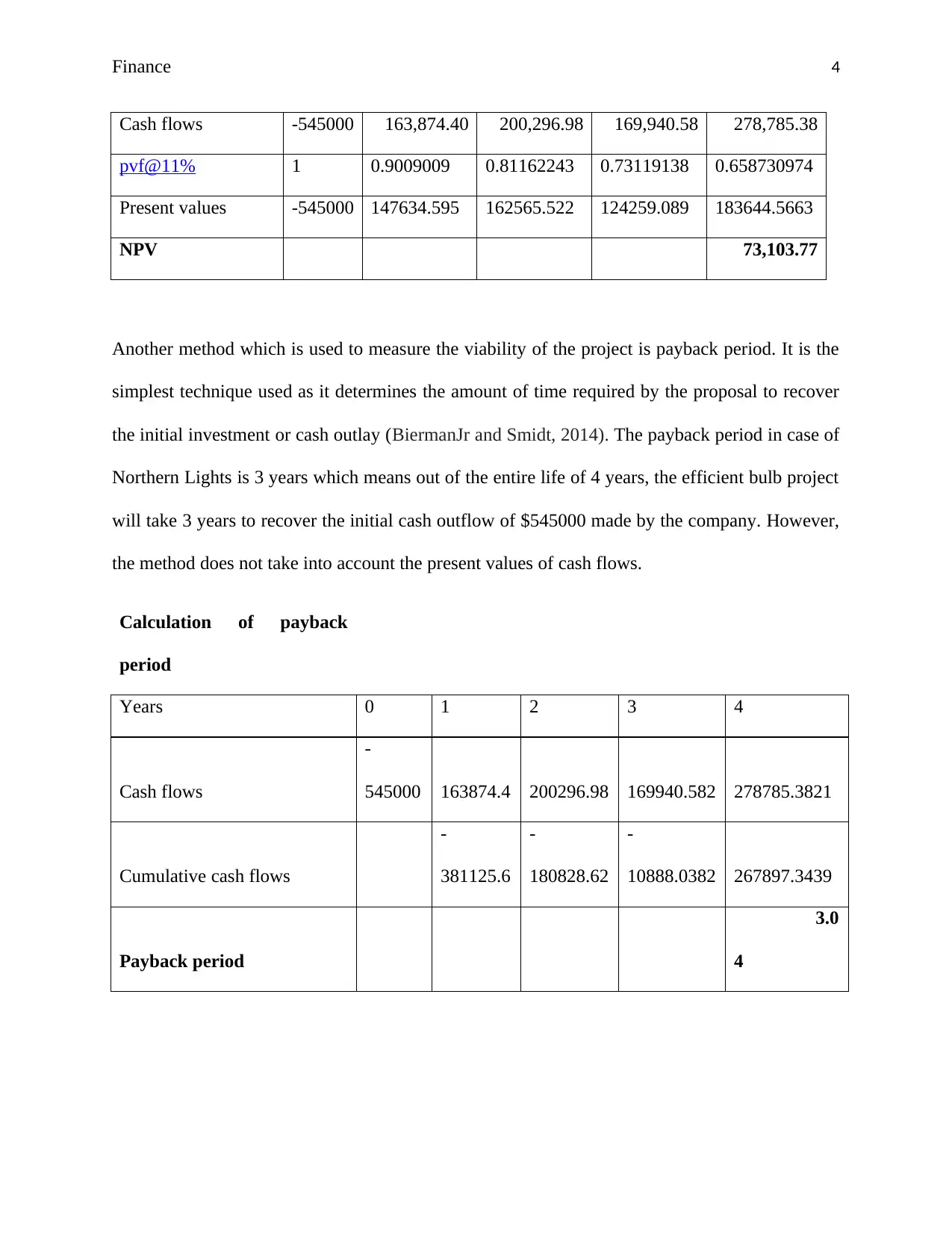
Finance 4
Cash flows -545000 163,874.40 200,296.98 169,940.58 278,785.38
pvf@11% 1 0.9009009 0.81162243 0.73119138 0.658730974
Present values -545000 147634.595 162565.522 124259.089 183644.5663
NPV 73,103.77
Another method which is used to measure the viability of the project is payback period. It is the
simplest technique used as it determines the amount of time required by the proposal to recover
the initial investment or cash outlay (BiermanJr and Smidt, 2014). The payback period in case of
Northern Lights is 3 years which means out of the entire life of 4 years, the efficient bulb project
will take 3 years to recover the initial cash outflow of $545000 made by the company. However,
the method does not take into account the present values of cash flows.
Calculation of payback
period
Years 0 1 2 3 4
Cash flows
-
545000 163874.4 200296.98 169940.582 278785.3821
Cumulative cash flows
-
381125.6
-
180828.62
-
10888.0382 267897.3439
Payback period
3.0
4
Cash flows -545000 163,874.40 200,296.98 169,940.58 278,785.38
pvf@11% 1 0.9009009 0.81162243 0.73119138 0.658730974
Present values -545000 147634.595 162565.522 124259.089 183644.5663
NPV 73,103.77
Another method which is used to measure the viability of the project is payback period. It is the
simplest technique used as it determines the amount of time required by the proposal to recover
the initial investment or cash outlay (BiermanJr and Smidt, 2014). The payback period in case of
Northern Lights is 3 years which means out of the entire life of 4 years, the efficient bulb project
will take 3 years to recover the initial cash outflow of $545000 made by the company. However,
the method does not take into account the present values of cash flows.
Calculation of payback
period
Years 0 1 2 3 4
Cash flows
-
545000 163874.4 200296.98 169940.582 278785.3821
Cumulative cash flows
-
381125.6
-
180828.62
-
10888.0382 267897.3439
Payback period
3.0
4
Secure Best Marks with AI Grader
Need help grading? Try our AI Grader for instant feedback on your assignments.
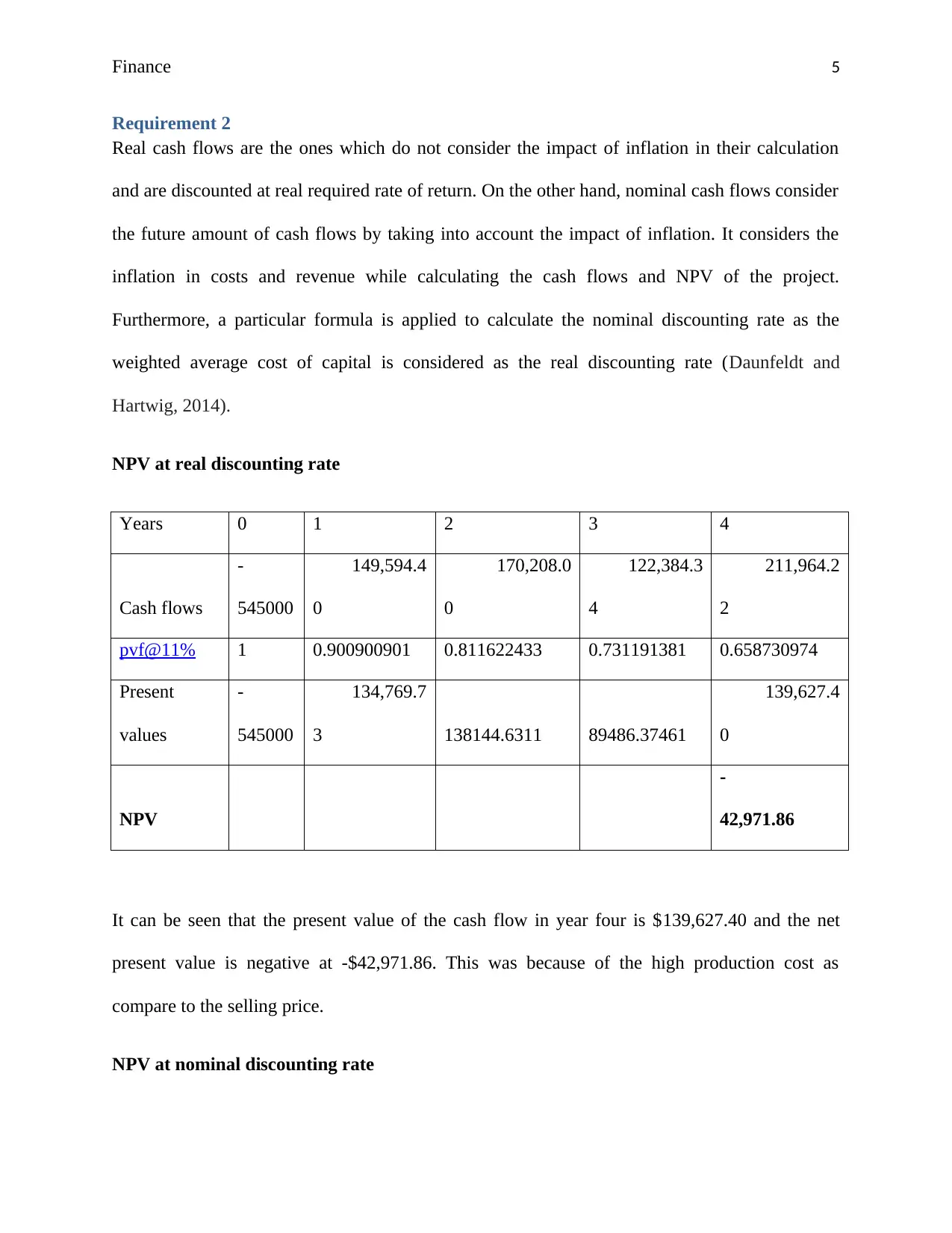
Finance 5
Requirement 2
Real cash flows are the ones which do not consider the impact of inflation in their calculation
and are discounted at real required rate of return. On the other hand, nominal cash flows consider
the future amount of cash flows by taking into account the impact of inflation. It considers the
inflation in costs and revenue while calculating the cash flows and NPV of the project.
Furthermore, a particular formula is applied to calculate the nominal discounting rate as the
weighted average cost of capital is considered as the real discounting rate (Daunfeldt and
Hartwig, 2014).
NPV at real discounting rate
Years 0 1 2 3 4
Cash flows
-
545000
149,594.4
0
170,208.0
0
122,384.3
4
211,964.2
2
pvf@11% 1 0.900900901 0.811622433 0.731191381 0.658730974
Present
values
-
545000
134,769.7
3 138144.6311 89486.37461
139,627.4
0
NPV
-
42,971.86
It can be seen that the present value of the cash flow in year four is $139,627.40 and the net
present value is negative at -$42,971.86. This was because of the high production cost as
compare to the selling price.
NPV at nominal discounting rate
Requirement 2
Real cash flows are the ones which do not consider the impact of inflation in their calculation
and are discounted at real required rate of return. On the other hand, nominal cash flows consider
the future amount of cash flows by taking into account the impact of inflation. It considers the
inflation in costs and revenue while calculating the cash flows and NPV of the project.
Furthermore, a particular formula is applied to calculate the nominal discounting rate as the
weighted average cost of capital is considered as the real discounting rate (Daunfeldt and
Hartwig, 2014).
NPV at real discounting rate
Years 0 1 2 3 4
Cash flows
-
545000
149,594.4
0
170,208.0
0
122,384.3
4
211,964.2
2
pvf@11% 1 0.900900901 0.811622433 0.731191381 0.658730974
Present
values
-
545000
134,769.7
3 138144.6311 89486.37461
139,627.4
0
NPV
-
42,971.86
It can be seen that the present value of the cash flow in year four is $139,627.40 and the net
present value is negative at -$42,971.86. This was because of the high production cost as
compare to the selling price.
NPV at nominal discounting rate
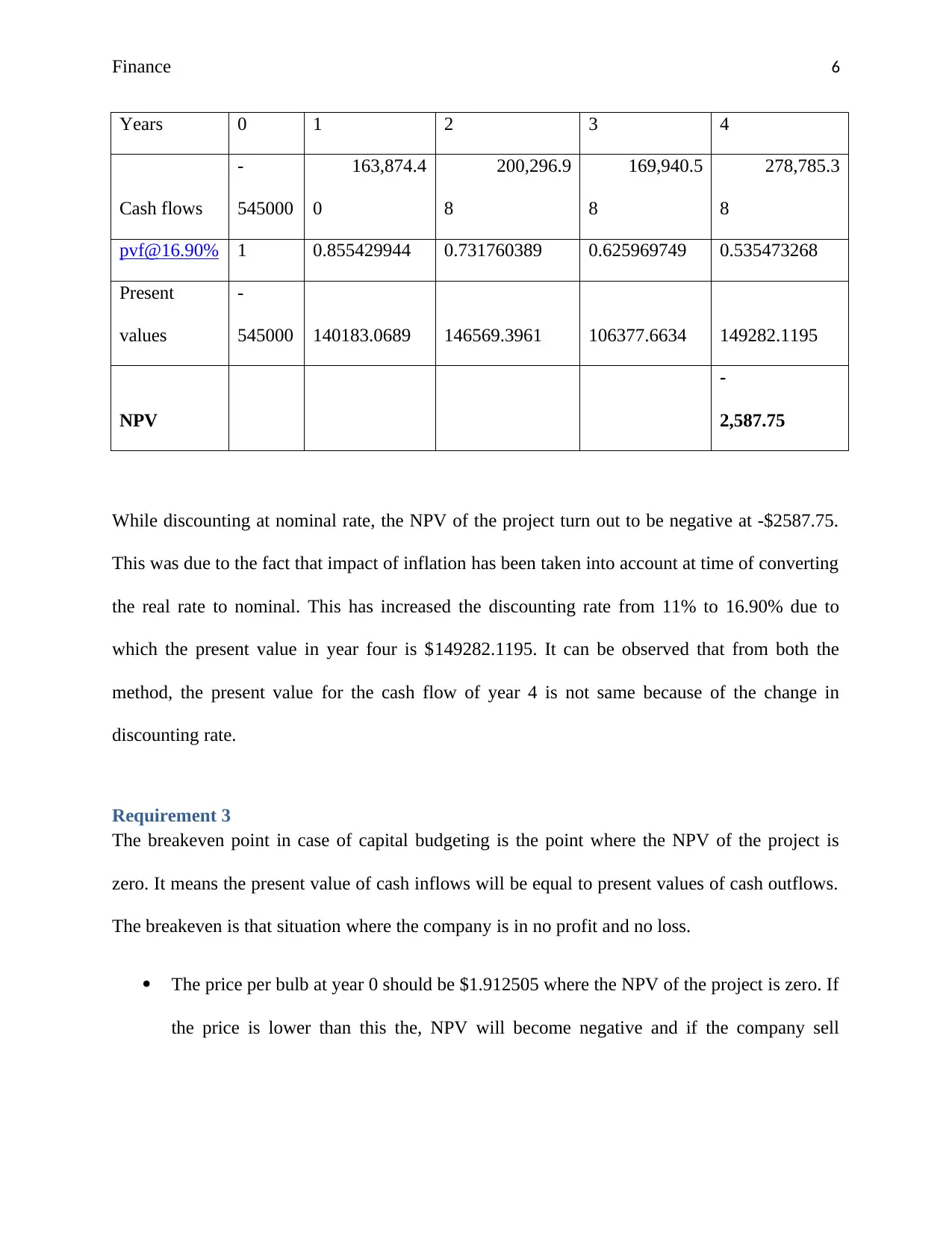
Finance 6
Years 0 1 2 3 4
Cash flows
-
545000
163,874.4
0
200,296.9
8
169,940.5
8
278,785.3
8
pvf@16.90% 1 0.855429944 0.731760389 0.625969749 0.535473268
Present
values
-
545000 140183.0689 146569.3961 106377.6634 149282.1195
NPV
-
2,587.75
While discounting at nominal rate, the NPV of the project turn out to be negative at -$2587.75.
This was due to the fact that impact of inflation has been taken into account at time of converting
the real rate to nominal. This has increased the discounting rate from 11% to 16.90% due to
which the present value in year four is $149282.1195. It can be observed that from both the
method, the present value for the cash flow of year 4 is not same because of the change in
discounting rate.
Requirement 3
The breakeven point in case of capital budgeting is the point where the NPV of the project is
zero. It means the present value of cash inflows will be equal to present values of cash outflows.
The breakeven is that situation where the company is in no profit and no loss.
The price per bulb at year 0 should be $1.912505 where the NPV of the project is zero. If
the price is lower than this the, NPV will become negative and if the company sell
Years 0 1 2 3 4
Cash flows
-
545000
163,874.4
0
200,296.9
8
169,940.5
8
278,785.3
8
pvf@16.90% 1 0.855429944 0.731760389 0.625969749 0.535473268
Present
values
-
545000 140183.0689 146569.3961 106377.6634 149282.1195
NPV
-
2,587.75
While discounting at nominal rate, the NPV of the project turn out to be negative at -$2587.75.
This was due to the fact that impact of inflation has been taken into account at time of converting
the real rate to nominal. This has increased the discounting rate from 11% to 16.90% due to
which the present value in year four is $149282.1195. It can be observed that from both the
method, the present value for the cash flow of year 4 is not same because of the change in
discounting rate.
Requirement 3
The breakeven point in case of capital budgeting is the point where the NPV of the project is
zero. It means the present value of cash inflows will be equal to present values of cash outflows.
The breakeven is that situation where the company is in no profit and no loss.
The price per bulb at year 0 should be $1.912505 where the NPV of the project is zero. If
the price is lower than this the, NPV will become negative and if the company sell
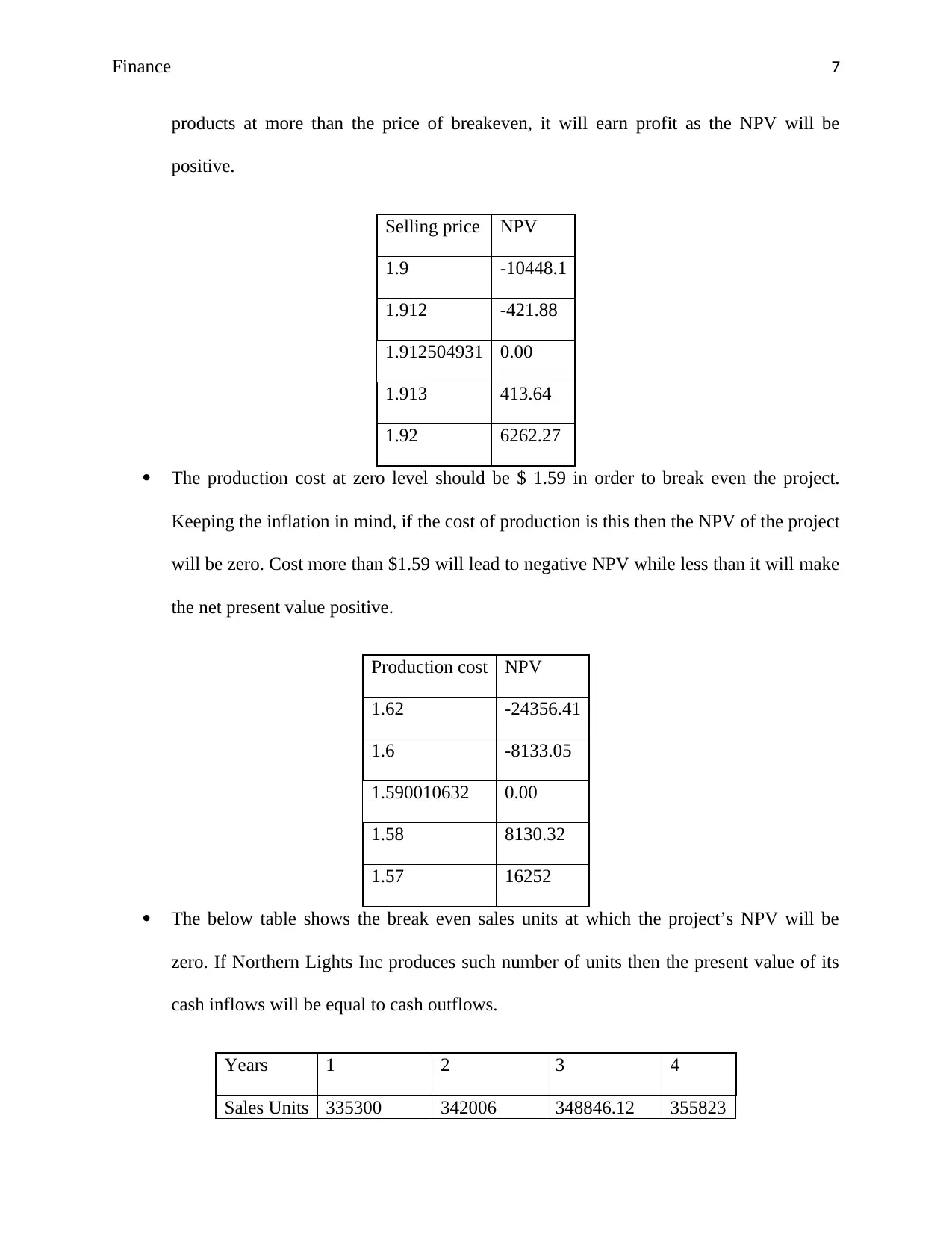
Finance 7
products at more than the price of breakeven, it will earn profit as the NPV will be
positive.
Selling price NPV
1.9 -10448.1
1.912 -421.88
1.912504931 0.00
1.913 413.64
1.92 6262.27
The production cost at zero level should be $ 1.59 in order to break even the project.
Keeping the inflation in mind, if the cost of production is this then the NPV of the project
will be zero. Cost more than $1.59 will lead to negative NPV while less than it will make
the net present value positive.
Production cost NPV
1.62 -24356.41
1.6 -8133.05
1.590010632 0.00
1.58 8130.32
1.57 16252
The below table shows the break even sales units at which the project’s NPV will be
zero. If Northern Lights Inc produces such number of units then the present value of its
cash inflows will be equal to cash outflows.
Years 1 2 3 4
Sales Units 335300 342006 348846.12 355823
products at more than the price of breakeven, it will earn profit as the NPV will be
positive.
Selling price NPV
1.9 -10448.1
1.912 -421.88
1.912504931 0.00
1.913 413.64
1.92 6262.27
The production cost at zero level should be $ 1.59 in order to break even the project.
Keeping the inflation in mind, if the cost of production is this then the NPV of the project
will be zero. Cost more than $1.59 will lead to negative NPV while less than it will make
the net present value positive.
Production cost NPV
1.62 -24356.41
1.6 -8133.05
1.590010632 0.00
1.58 8130.32
1.57 16252
The below table shows the break even sales units at which the project’s NPV will be
zero. If Northern Lights Inc produces such number of units then the present value of its
cash inflows will be equal to cash outflows.
Years 1 2 3 4
Sales Units 335300 342006 348846.12 355823
Paraphrase This Document
Need a fresh take? Get an instant paraphrase of this document with our AI Paraphraser
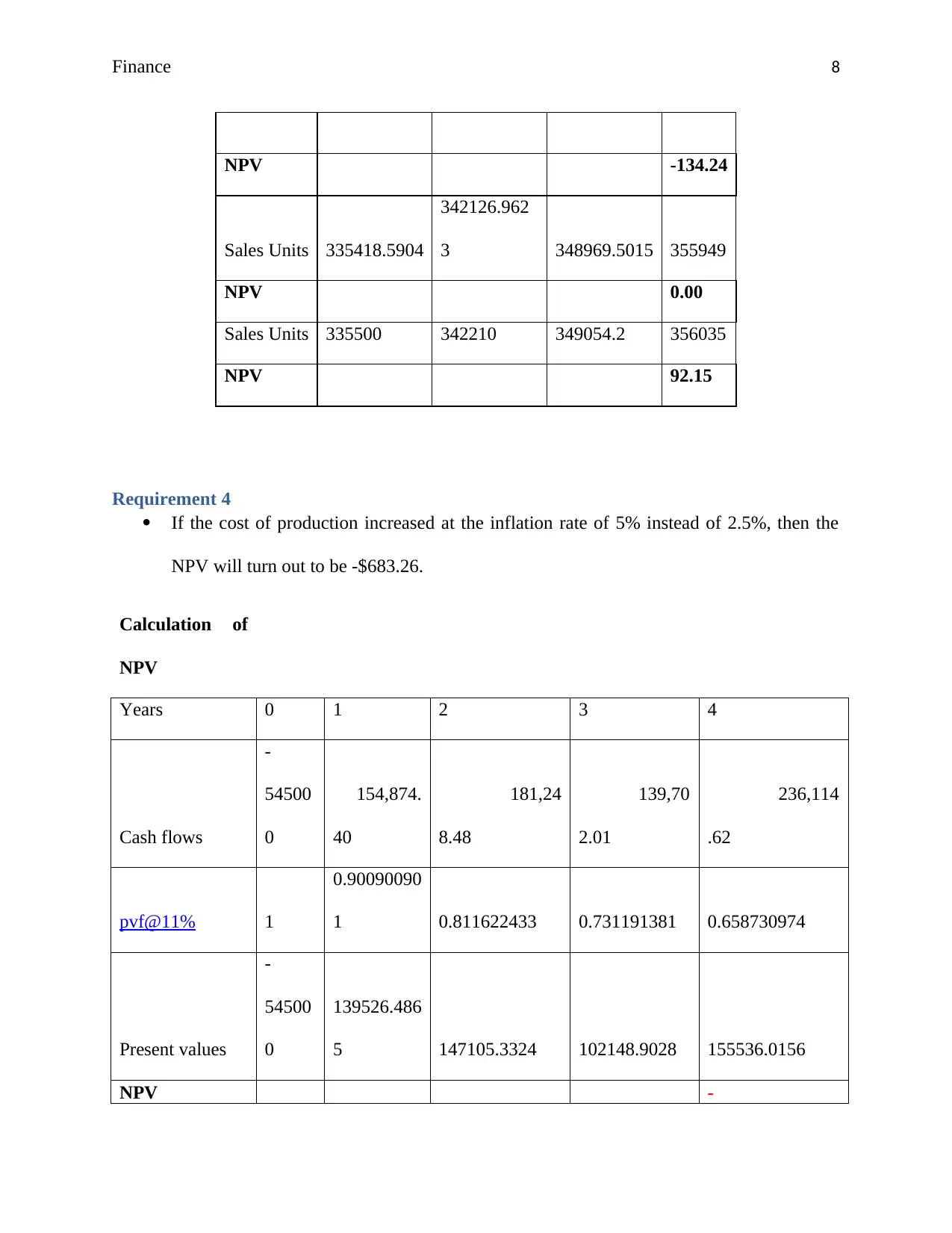
Finance 8
NPV -134.24
Sales Units 335418.5904
342126.962
3 348969.5015 355949
NPV 0.00
Sales Units 335500 342210 349054.2 356035
NPV 92.15
Requirement 4
If the cost of production increased at the inflation rate of 5% instead of 2.5%, then the
NPV will turn out to be -$683.26.
Calculation of
NPV
Years 0 1 2 3 4
Cash flows
-
54500
0
154,874.
40
181,24
8.48
139,70
2.01
236,114
.62
pvf@11% 1
0.90090090
1 0.811622433 0.731191381 0.658730974
Present values
-
54500
0
139526.486
5 147105.3324 102148.9028 155536.0156
NPV -
NPV -134.24
Sales Units 335418.5904
342126.962
3 348969.5015 355949
NPV 0.00
Sales Units 335500 342210 349054.2 356035
NPV 92.15
Requirement 4
If the cost of production increased at the inflation rate of 5% instead of 2.5%, then the
NPV will turn out to be -$683.26.
Calculation of
NPV
Years 0 1 2 3 4
Cash flows
-
54500
0
154,874.
40
181,24
8.48
139,70
2.01
236,114
.62
pvf@11% 1
0.90090090
1 0.811622433 0.731191381 0.658730974
Present values
-
54500
0
139526.486
5 147105.3324 102148.9028 155536.0156
NPV -
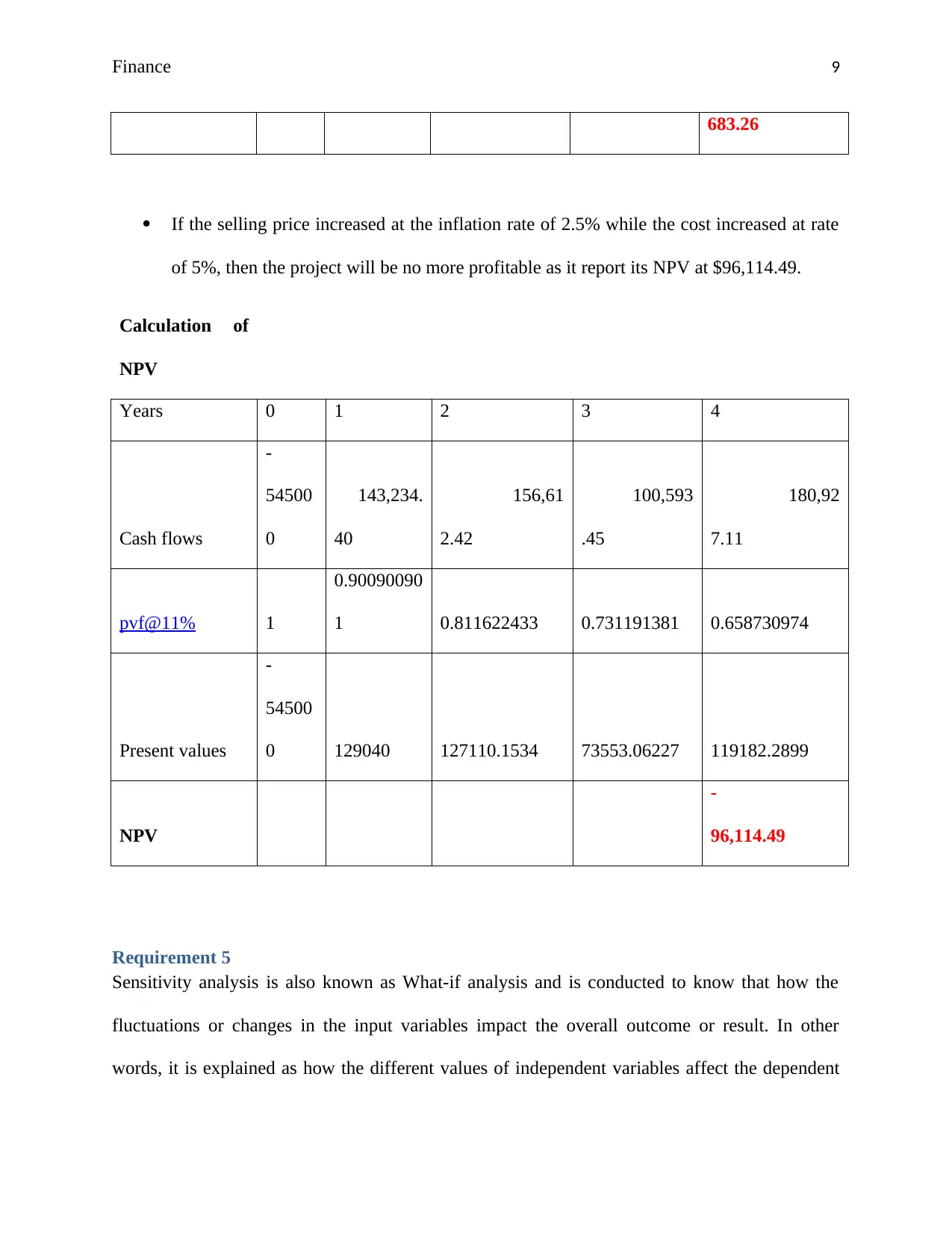
Finance 9
683.26
If the selling price increased at the inflation rate of 2.5% while the cost increased at rate
of 5%, then the project will be no more profitable as it report its NPV at $96,114.49.
Calculation of
NPV
Years 0 1 2 3 4
Cash flows
-
54500
0
143,234.
40
156,61
2.42
100,593
.45
180,92
7.11
pvf@11% 1
0.90090090
1 0.811622433 0.731191381 0.658730974
Present values
-
54500
0 129040 127110.1534 73553.06227 119182.2899
NPV
-
96,114.49
Requirement 5
Sensitivity analysis is also known as What-if analysis and is conducted to know that how the
fluctuations or changes in the input variables impact the overall outcome or result. In other
words, it is explained as how the different values of independent variables affect the dependent
683.26
If the selling price increased at the inflation rate of 2.5% while the cost increased at rate
of 5%, then the project will be no more profitable as it report its NPV at $96,114.49.
Calculation of
NPV
Years 0 1 2 3 4
Cash flows
-
54500
0
143,234.
40
156,61
2.42
100,593
.45
180,92
7.11
pvf@11% 1
0.90090090
1 0.811622433 0.731191381 0.658730974
Present values
-
54500
0 129040 127110.1534 73553.06227 119182.2899
NPV
-
96,114.49
Requirement 5
Sensitivity analysis is also known as What-if analysis and is conducted to know that how the
fluctuations or changes in the input variables impact the overall outcome or result. In other
words, it is explained as how the different values of independent variables affect the dependent

Finance 10
variable under a provided set of assumptions. The analysis is done to note the profitability of the
project under different circumstances such as increase or decrease in selling price, changes in
interest rates and others (Borgonovo, 2017).
In case of Northern Lights, three input variables are considered to perform the sensitivity
analysis. They are the machinery salvage value in the year four, sales of year one and the
discounting rate. An increase and decrease of 10%, 20% and 30% has been shown in all these
three variables and the impact of NPV has been noticed.
Machinery salvage value
Summary 10% 20% 30%
Increase Decrease Increase Decrease Increase Decrease
Salvage
value
110,000.
00
90,000.
00
120,000.
00
80,000.
00
130,000.
00
70,000.
00
NPV
79,691.
08
66,516.
46
86,278.
39
59,929.
15
92,865.
70
53,341.
84
The above table record the increase and decrease in salvage value from 10% to 30%. It can be
observed that if there is an increase in the salvage value with respective percentages than the
NPV of the project will increase from $79,691.08 to $92,865.70. On the other hand, the decrease
in the same will make the NPV to fall from $66516.46 to $53341.84. Thus, it is interpreted that
the value must increase in order to generate high and positive NPV.
Sales units
variable under a provided set of assumptions. The analysis is done to note the profitability of the
project under different circumstances such as increase or decrease in selling price, changes in
interest rates and others (Borgonovo, 2017).
In case of Northern Lights, three input variables are considered to perform the sensitivity
analysis. They are the machinery salvage value in the year four, sales of year one and the
discounting rate. An increase and decrease of 10%, 20% and 30% has been shown in all these
three variables and the impact of NPV has been noticed.
Machinery salvage value
Summary 10% 20% 30%
Increase Decrease Increase Decrease Increase Decrease
Salvage
value
110,000.
00
90,000.
00
120,000.
00
80,000.
00
130,000.
00
70,000.
00
NPV
79,691.
08
66,516.
46
86,278.
39
59,929.
15
92,865.
70
53,341.
84
The above table record the increase and decrease in salvage value from 10% to 30%. It can be
observed that if there is an increase in the salvage value with respective percentages than the
NPV of the project will increase from $79,691.08 to $92,865.70. On the other hand, the decrease
in the same will make the NPV to fall from $66516.46 to $53341.84. Thus, it is interpreted that
the value must increase in order to generate high and positive NPV.
Sales units
Secure Best Marks with AI Grader
Need help grading? Try our AI Grader for instant feedback on your assignments.
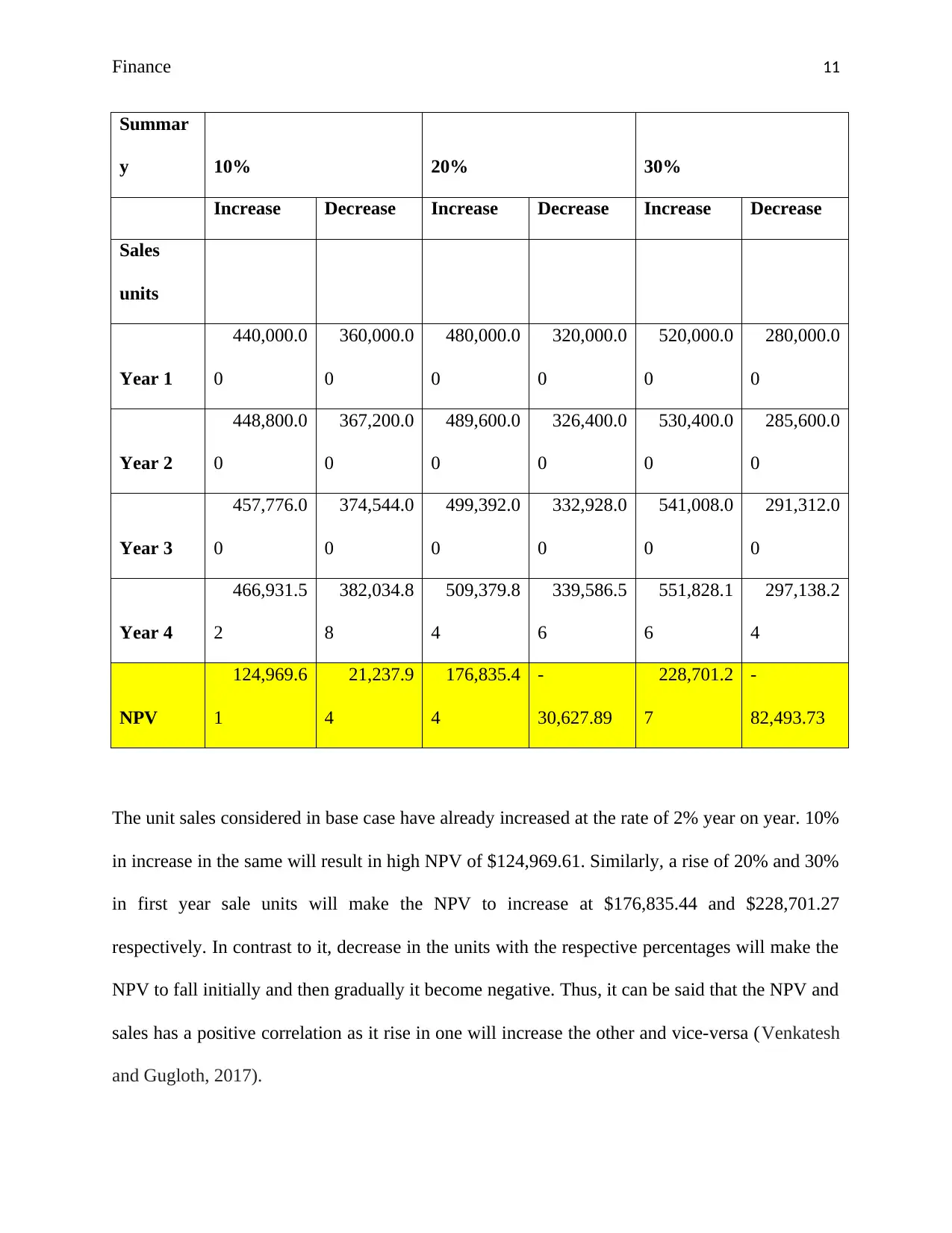
Finance 11
Summar
y 10% 20% 30%
Increase Decrease Increase Decrease Increase Decrease
Sales
units
Year 1
440,000.0
0
360,000.0
0
480,000.0
0
320,000.0
0
520,000.0
0
280,000.0
0
Year 2
448,800.0
0
367,200.0
0
489,600.0
0
326,400.0
0
530,400.0
0
285,600.0
0
Year 3
457,776.0
0
374,544.0
0
499,392.0
0
332,928.0
0
541,008.0
0
291,312.0
0
Year 4
466,931.5
2
382,034.8
8
509,379.8
4
339,586.5
6
551,828.1
6
297,138.2
4
NPV
124,969.6
1
21,237.9
4
176,835.4
4
-
30,627.89
228,701.2
7
-
82,493.73
The unit sales considered in base case have already increased at the rate of 2% year on year. 10%
in increase in the same will result in high NPV of $124,969.61. Similarly, a rise of 20% and 30%
in first year sale units will make the NPV to increase at $176,835.44 and $228,701.27
respectively. In contrast to it, decrease in the units with the respective percentages will make the
NPV to fall initially and then gradually it become negative. Thus, it can be said that the NPV and
sales has a positive correlation as it rise in one will increase the other and vice-versa (Venkatesh
and Gugloth, 2017).
Summar
y 10% 20% 30%
Increase Decrease Increase Decrease Increase Decrease
Sales
units
Year 1
440,000.0
0
360,000.0
0
480,000.0
0
320,000.0
0
520,000.0
0
280,000.0
0
Year 2
448,800.0
0
367,200.0
0
489,600.0
0
326,400.0
0
530,400.0
0
285,600.0
0
Year 3
457,776.0
0
374,544.0
0
499,392.0
0
332,928.0
0
541,008.0
0
291,312.0
0
Year 4
466,931.5
2
382,034.8
8
509,379.8
4
339,586.5
6
551,828.1
6
297,138.2
4
NPV
124,969.6
1
21,237.9
4
176,835.4
4
-
30,627.89
228,701.2
7
-
82,493.73
The unit sales considered in base case have already increased at the rate of 2% year on year. 10%
in increase in the same will result in high NPV of $124,969.61. Similarly, a rise of 20% and 30%
in first year sale units will make the NPV to increase at $176,835.44 and $228,701.27
respectively. In contrast to it, decrease in the units with the respective percentages will make the
NPV to fall initially and then gradually it become negative. Thus, it can be said that the NPV and
sales has a positive correlation as it rise in one will increase the other and vice-versa (Venkatesh
and Gugloth, 2017).
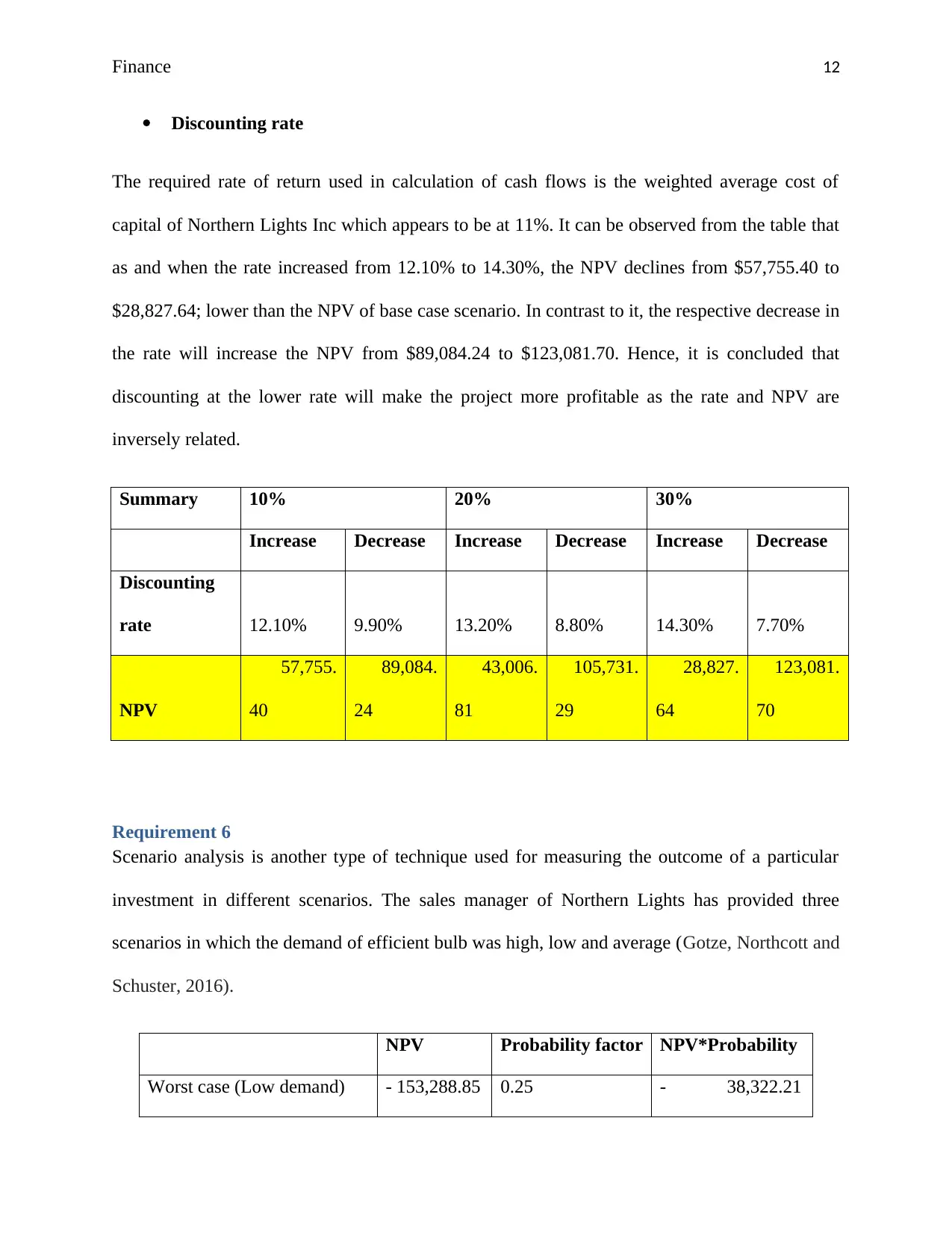
Finance 12
Discounting rate
The required rate of return used in calculation of cash flows is the weighted average cost of
capital of Northern Lights Inc which appears to be at 11%. It can be observed from the table that
as and when the rate increased from 12.10% to 14.30%, the NPV declines from $57,755.40 to
$28,827.64; lower than the NPV of base case scenario. In contrast to it, the respective decrease in
the rate will increase the NPV from $89,084.24 to $123,081.70. Hence, it is concluded that
discounting at the lower rate will make the project more profitable as the rate and NPV are
inversely related.
Summary 10% 20% 30%
Increase Decrease Increase Decrease Increase Decrease
Discounting
rate 12.10% 9.90% 13.20% 8.80% 14.30% 7.70%
NPV
57,755.
40
89,084.
24
43,006.
81
105,731.
29
28,827.
64
123,081.
70
Requirement 6
Scenario analysis is another type of technique used for measuring the outcome of a particular
investment in different scenarios. The sales manager of Northern Lights has provided three
scenarios in which the demand of efficient bulb was high, low and average (Gotze, Northcott and
Schuster, 2016).
NPV Probability factor NPV*Probability
Worst case (Low demand) - 153,288.85 0.25 - 38,322.21
Discounting rate
The required rate of return used in calculation of cash flows is the weighted average cost of
capital of Northern Lights Inc which appears to be at 11%. It can be observed from the table that
as and when the rate increased from 12.10% to 14.30%, the NPV declines from $57,755.40 to
$28,827.64; lower than the NPV of base case scenario. In contrast to it, the respective decrease in
the rate will increase the NPV from $89,084.24 to $123,081.70. Hence, it is concluded that
discounting at the lower rate will make the project more profitable as the rate and NPV are
inversely related.
Summary 10% 20% 30%
Increase Decrease Increase Decrease Increase Decrease
Discounting
rate 12.10% 9.90% 13.20% 8.80% 14.30% 7.70%
NPV
57,755.
40
89,084.
24
43,006.
81
105,731.
29
28,827.
64
123,081.
70
Requirement 6
Scenario analysis is another type of technique used for measuring the outcome of a particular
investment in different scenarios. The sales manager of Northern Lights has provided three
scenarios in which the demand of efficient bulb was high, low and average (Gotze, Northcott and
Schuster, 2016).
NPV Probability factor NPV*Probability
Worst case (Low demand) - 153,288.85 0.25 - 38,322.21
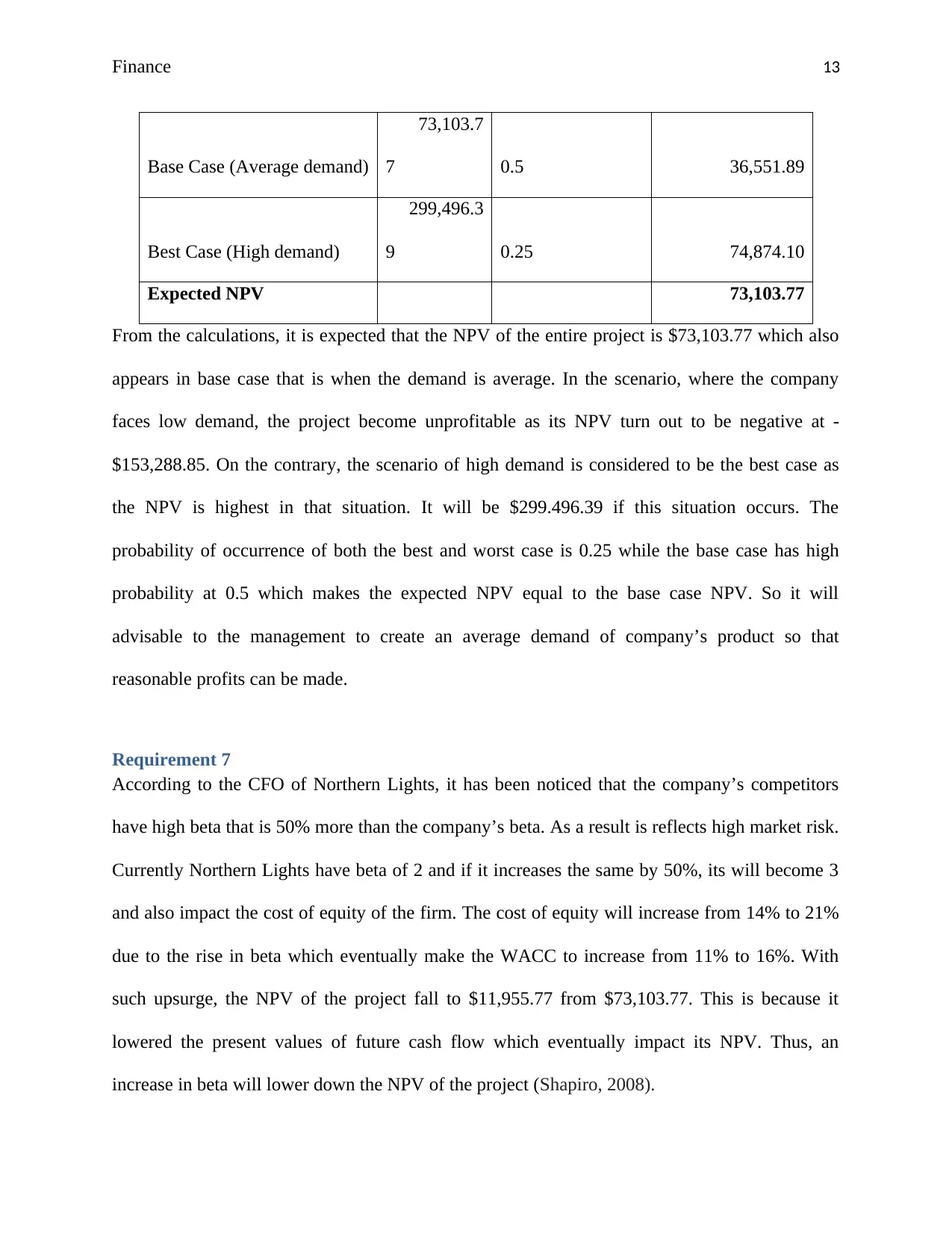
Finance 13
Base Case (Average demand)
73,103.7
7 0.5 36,551.89
Best Case (High demand)
299,496.3
9 0.25 74,874.10
Expected NPV 73,103.77
From the calculations, it is expected that the NPV of the entire project is $73,103.77 which also
appears in base case that is when the demand is average. In the scenario, where the company
faces low demand, the project become unprofitable as its NPV turn out to be negative at -
$153,288.85. On the contrary, the scenario of high demand is considered to be the best case as
the NPV is highest in that situation. It will be $299.496.39 if this situation occurs. The
probability of occurrence of both the best and worst case is 0.25 while the base case has high
probability at 0.5 which makes the expected NPV equal to the base case NPV. So it will
advisable to the management to create an average demand of company’s product so that
reasonable profits can be made.
Requirement 7
According to the CFO of Northern Lights, it has been noticed that the company’s competitors
have high beta that is 50% more than the company’s beta. As a result is reflects high market risk.
Currently Northern Lights have beta of 2 and if it increases the same by 50%, its will become 3
and also impact the cost of equity of the firm. The cost of equity will increase from 14% to 21%
due to the rise in beta which eventually make the WACC to increase from 11% to 16%. With
such upsurge, the NPV of the project fall to $11,955.77 from $73,103.77. This is because it
lowered the present values of future cash flow which eventually impact its NPV. Thus, an
increase in beta will lower down the NPV of the project (Shapiro, 2008).
Base Case (Average demand)
73,103.7
7 0.5 36,551.89
Best Case (High demand)
299,496.3
9 0.25 74,874.10
Expected NPV 73,103.77
From the calculations, it is expected that the NPV of the entire project is $73,103.77 which also
appears in base case that is when the demand is average. In the scenario, where the company
faces low demand, the project become unprofitable as its NPV turn out to be negative at -
$153,288.85. On the contrary, the scenario of high demand is considered to be the best case as
the NPV is highest in that situation. It will be $299.496.39 if this situation occurs. The
probability of occurrence of both the best and worst case is 0.25 while the base case has high
probability at 0.5 which makes the expected NPV equal to the base case NPV. So it will
advisable to the management to create an average demand of company’s product so that
reasonable profits can be made.
Requirement 7
According to the CFO of Northern Lights, it has been noticed that the company’s competitors
have high beta that is 50% more than the company’s beta. As a result is reflects high market risk.
Currently Northern Lights have beta of 2 and if it increases the same by 50%, its will become 3
and also impact the cost of equity of the firm. The cost of equity will increase from 14% to 21%
due to the rise in beta which eventually make the WACC to increase from 11% to 16%. With
such upsurge, the NPV of the project fall to $11,955.77 from $73,103.77. This is because it
lowered the present values of future cash flow which eventually impact its NPV. Thus, an
increase in beta will lower down the NPV of the project (Shapiro, 2008).
Paraphrase This Document
Need a fresh take? Get an instant paraphrase of this document with our AI Paraphraser
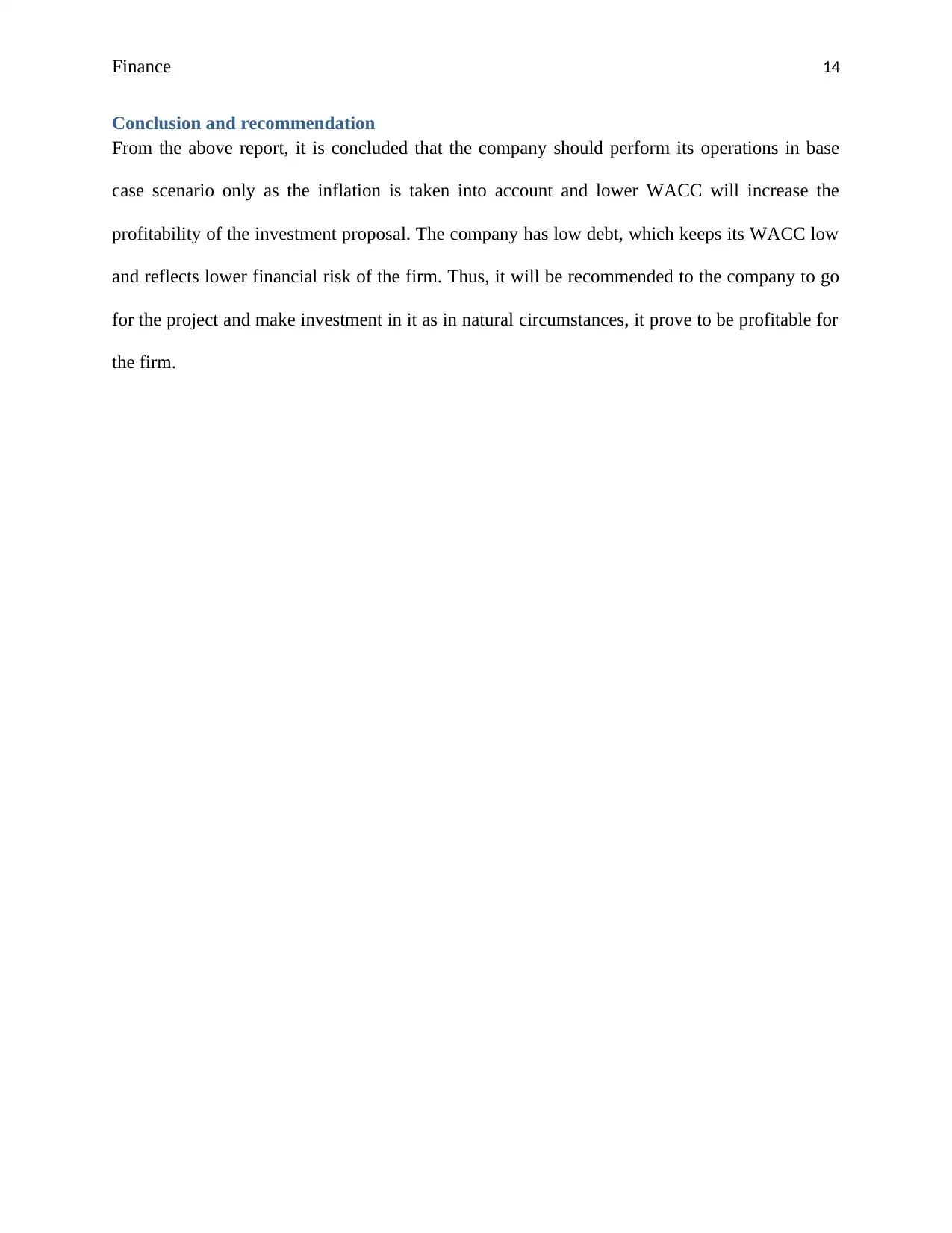
Finance 14
Conclusion and recommendation
From the above report, it is concluded that the company should perform its operations in base
case scenario only as the inflation is taken into account and lower WACC will increase the
profitability of the investment proposal. The company has low debt, which keeps its WACC low
and reflects lower financial risk of the firm. Thus, it will be recommended to the company to go
for the project and make investment in it as in natural circumstances, it prove to be profitable for
the firm.
Conclusion and recommendation
From the above report, it is concluded that the company should perform its operations in base
case scenario only as the inflation is taken into account and lower WACC will increase the
profitability of the investment proposal. The company has low debt, which keeps its WACC low
and reflects lower financial risk of the firm. Thus, it will be recommended to the company to go
for the project and make investment in it as in natural circumstances, it prove to be profitable for
the firm.
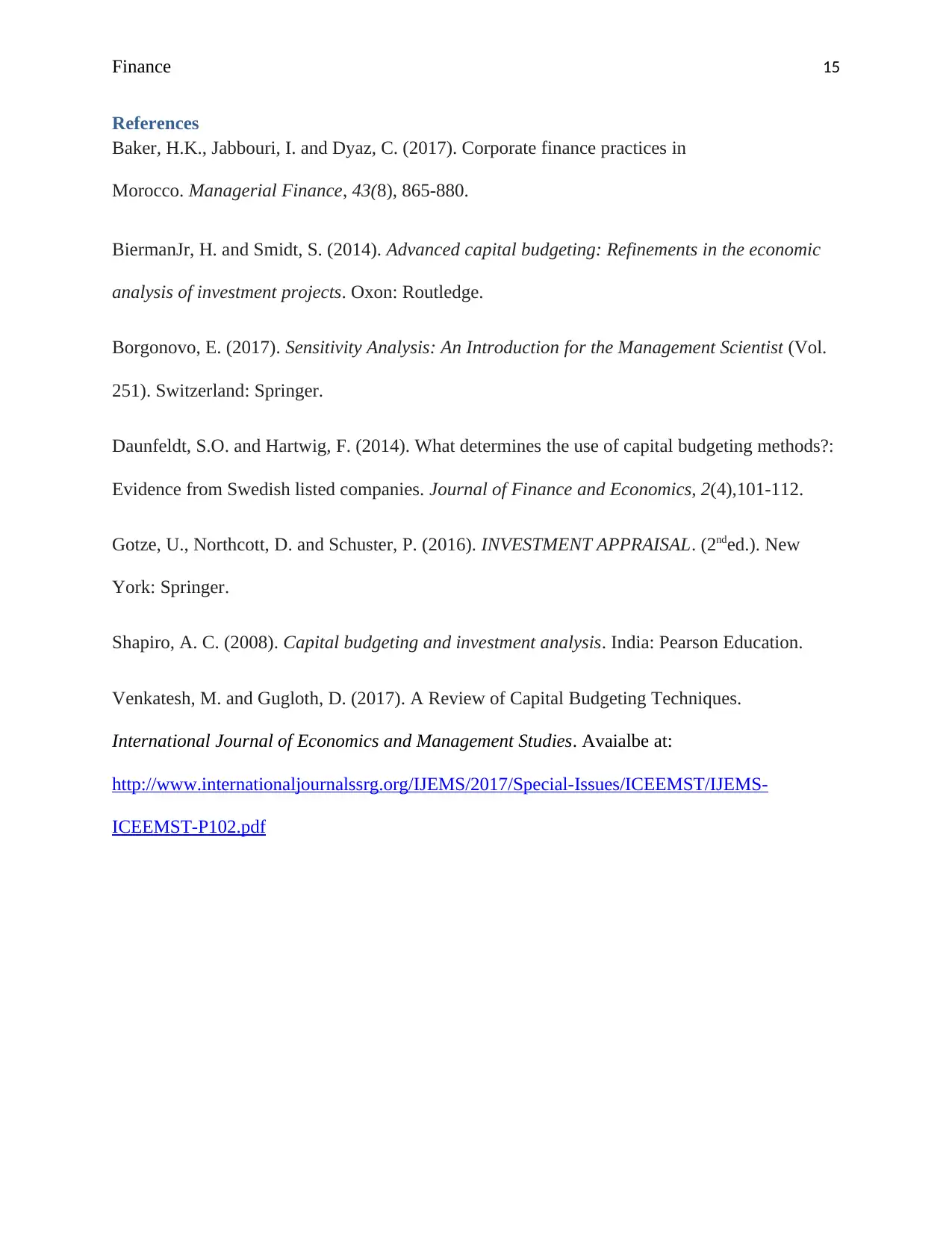
Finance 15
References
Baker, H.K., Jabbouri, I. and Dyaz, C. (2017). Corporate finance practices in
Morocco. Managerial Finance, 43(8), 865-880.
BiermanJr, H. and Smidt, S. (2014). Advanced capital budgeting: Refinements in the economic
analysis of investment projects. Oxon: Routledge.
Borgonovo, E. (2017). Sensitivity Analysis: An Introduction for the Management Scientist (Vol.
251). Switzerland: Springer.
Daunfeldt, S.O. and Hartwig, F. (2014). What determines the use of capital budgeting methods?:
Evidence from Swedish listed companies. Journal of Finance and Economics, 2(4),101-112.
Gotze, U., Northcott, D. and Schuster, P. (2016). INVESTMENT APPRAISAL. (2nded.). New
York: Springer.
Shapiro, A. C. (2008). Capital budgeting and investment analysis. India: Pearson Education.
Venkatesh, M. and Gugloth, D. (2017). A Review of Capital Budgeting Techniques.
International Journal of Economics and Management Studies. Avaialbe at:
http://www.internationaljournalssrg.org/IJEMS/2017/Special-Issues/ICEEMST/IJEMS-
ICEEMST-P102.pdf
References
Baker, H.K., Jabbouri, I. and Dyaz, C. (2017). Corporate finance practices in
Morocco. Managerial Finance, 43(8), 865-880.
BiermanJr, H. and Smidt, S. (2014). Advanced capital budgeting: Refinements in the economic
analysis of investment projects. Oxon: Routledge.
Borgonovo, E. (2017). Sensitivity Analysis: An Introduction for the Management Scientist (Vol.
251). Switzerland: Springer.
Daunfeldt, S.O. and Hartwig, F. (2014). What determines the use of capital budgeting methods?:
Evidence from Swedish listed companies. Journal of Finance and Economics, 2(4),101-112.
Gotze, U., Northcott, D. and Schuster, P. (2016). INVESTMENT APPRAISAL. (2nded.). New
York: Springer.
Shapiro, A. C. (2008). Capital budgeting and investment analysis. India: Pearson Education.
Venkatesh, M. and Gugloth, D. (2017). A Review of Capital Budgeting Techniques.
International Journal of Economics and Management Studies. Avaialbe at:
http://www.internationaljournalssrg.org/IJEMS/2017/Special-Issues/ICEEMST/IJEMS-
ICEEMST-P102.pdf
1 out of 15
Related Documents
Your All-in-One AI-Powered Toolkit for Academic Success.
+13062052269
info@desklib.com
Available 24*7 on WhatsApp / Email
![[object Object]](/_next/static/media/star-bottom.7253800d.svg)
Unlock your academic potential
© 2024 | Zucol Services PVT LTD | All rights reserved.





